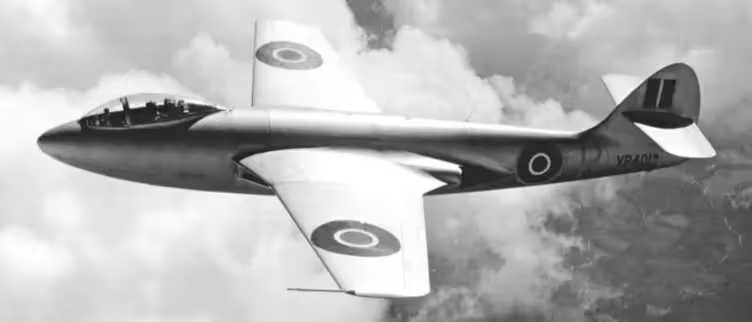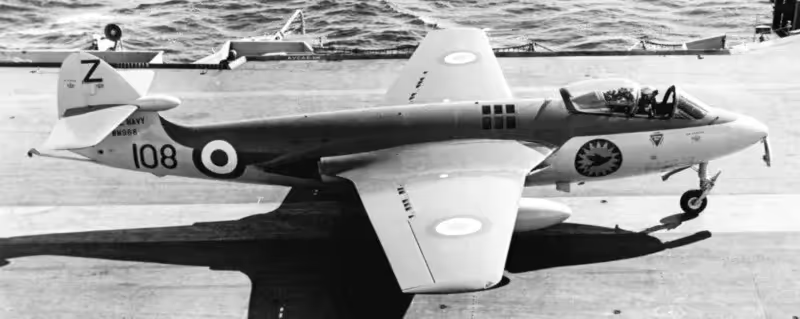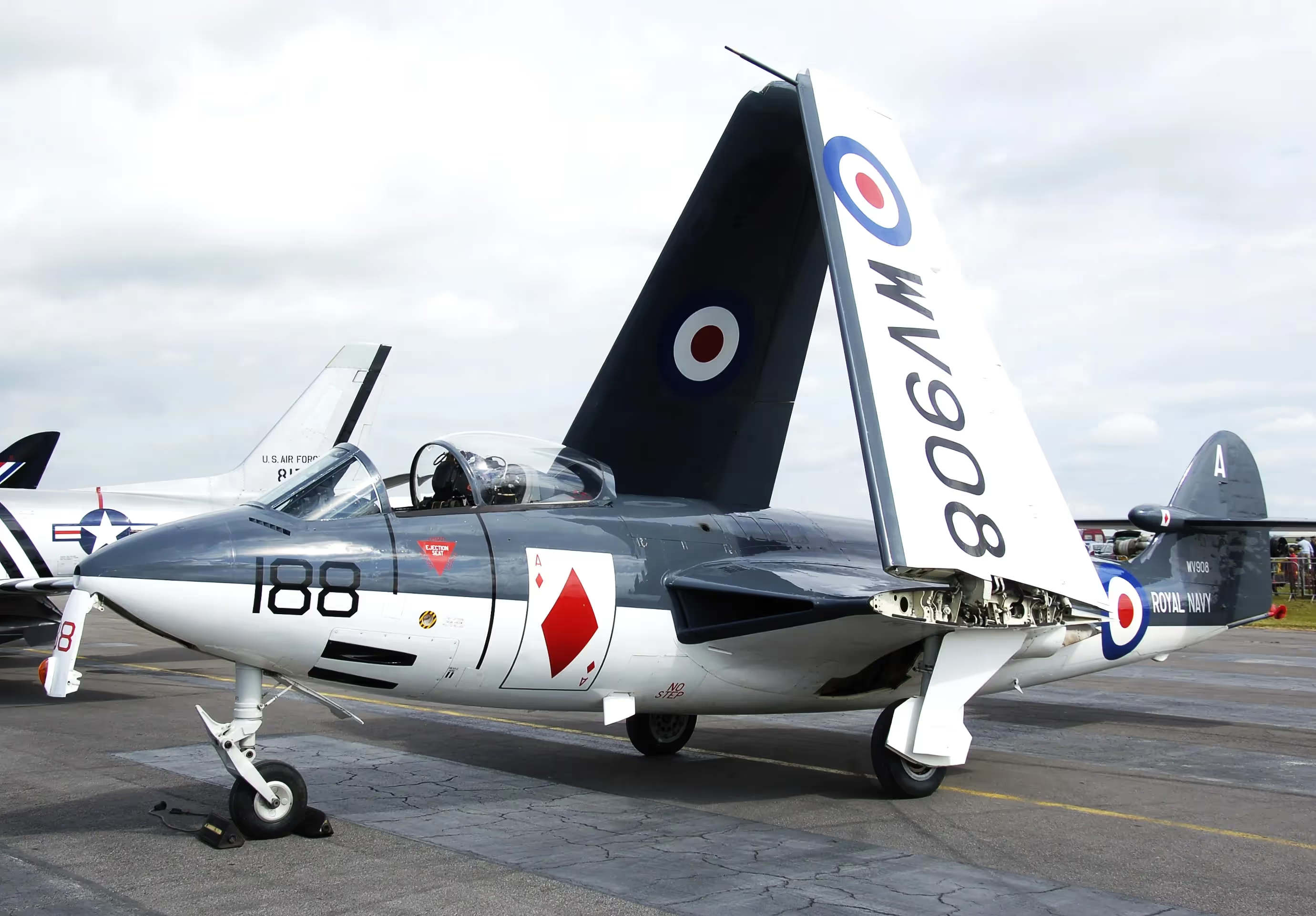Warplanes of the UK: Hawker Sea Hawk
Hawker Sea Hawk

(Ronnie Macdonald Photo)
Royal Navy Hawker Sea Hawk (Serial No. WV908) on landing approach. WV908, built in 1954, is the only airworthy Sea Hawk and is flown in the UK by the Royal Navy Historic Flight.
The Hawker Sea Hawk is a British single-seat jet day fighter formerly of the Fleet Air Arm (FAA), the air branch of the Royal Navy (RN), built by Hawker Aircraft and its sister company, Armstrong Whitworth Aircraft. Although its design originated from earlier Hawker piston-engined fighters, the Sea Hawk was the company's first jet aircraft.Following acceptance in the RN, the Sea Hawk proved to be a reliable and sturdy workhorse. A considerable number were also produced for the export market and were operated from aircraft carriers in Dutch and Indian service. The last operational Sea Hawks, operated by the Indian Navy, were retired in 1983.
The first production Sea Hawk was the F 1, which first flew in 1951, entered service two years later with 806 Squadron, first based at Brawdy, then transferred to HMS Eagle. All Sea Hawks were in service by the mid-1950s and eventually over 500 were built.During service evaluations of the Sea Hawk, Australian and Canadian naval pilots flew the aircraft leading to official suggestions that the aircraft would be chosen by the two countries. Both nations were also interested in new American-built naval aircraft.
The Sea Hawk saw extensive service during the Suez Crisis, when joint Anglo-French forces invaded Egypt on 31 October 1956 under Operation Musketeer. Six Sea Hawk squadrons took part: two aboard the fleet carrier HMS Eagle and two each aboard the light fleet carriers HMS Albion and HMS Bulwark. The Sea Hawks were primarily used for ground attack. Due to aircraft such as the Hunter lacking the range or clearance to deliver munitions, the entire British ground attack capability during the conflict was delivered by the navy Sea Hawks and the Westland Wyverns of 830 Squadron, typically being escorted by de Havilland Sea Venom fighters.
Sea Hawks launched many attacks upon Egyptian shore-based targets, often in the face of heavy anti-aircraft fire, resulting in several aircraft being severely damaged. The Suez Crisis was to be the swan song of Sea Hawk combat operations with the Royal Navy, as new strike aircraft such as the de Havilland Sea Vixen and the Supermarine Scimitar were introduced after the conflict. The Sea Hawks in Fleet Air Arm service began being phased out from first line service in 1958, the year in which the Supermarine Scimitar and de Havilland Sea Vixen entered service, both of which types would eventually replace the Sea Hawk. (Wikipedia)

(RN Photo)
The first prototype of the P.1040 flew on 2 September 1947, powered by a Nene 1 engine, with 20.02 kN (2,040 kgp / 4,500 lbf) thrust. The project was announced to the public a month later, disguised for some forgotten reason as a purely company-financed effort. This pretense was dropped when the second prototype flew a year later, on 3 September 1948. The second prototype had folding wings, a stinger-type arresting hook, and was fully armed. The second prototype was used in carrier trials that indicated a need for a slightly wider wingspan and longer arresting hook.



(Royal Navy Photos)
Hawker Sea Hawk.

(Smudge 9000 Photo)
Hawker Sea Hawk (Serial No. WV908) was built at Baginton, Coventry in 1954 by Armstrong-Whitworth.

(Adrian Pingstone Photo)
Hawker Sea Hawk FGA.6 (Serial No. WV908), Royal Navy Historic Flight, 2008. First flight 1954, retired 1962, restoration began in 1976.

(Alan Wilson Photo)
Hawker Sea Hawk FGA.6 (Serial No. WV856), 163, on display in the Fleet Air Arm Museum, Yeovilton, UK.
.avif)
.avif)
(Alan Wilson Photos)
Hawker Sea Hawk (Serial No. WM969), c/n AW.6007. Built 1954. On display in Hangar 3 at the Imperial War Museum, Duxford Airfield, Cambridgeshire, UK, 2018.
.avif)
(Alan Wilson Photo)
Armstrong Whitworth Sea Hawk FGA.6 (Serial No. WV797), c/n 6058. Built at Baginton by Armstrong-Whitworth in 1954 and returned there for preservation in 1985. Currently wearing Suez markings, she saw Royal Navy service with Nos. 787, 899, 898 and 738 Squadrons. On display at the Midland Air Museum, Coventry Airport, UK.

(Snowmanradio Photo)
Armstrong Whitworth Sea Hawk FGA.6 (Serial No. WV797) at the Midland Air Museum, near Baginton, Warwickshire, UK.

(Alan Wilson Photo)
Hawker Sea Hawk (Serial No. WM913), c/n AW.5965. Built in 1954. Served with Nos. 806, 897, 895, 700 and 736 Naval Air Squadrons. To the School of Aircraft Handling (SAH) at Culdrose in June 1961 and allocated the maintenance serial A2510. Put on display at RAF Sealand in 1971 and allocated the RAF maintenance serial 8162M, which she never wore. She went to the Fleetwood Sea Cadets in 1976 and then came to Newark on 1st July 1984. She is preserved in the markings of 897NAS while serving on HMS Eagle between April 1956 and January 1957. On display in Hangar 1, Newark Air Museum Winthorpe, Nottinghamshire, UK, 2020.
.avif)
(Alan Wilson Photo)
Hawker Sea Hawk (Serial No. WV826), c/n 6071. Built as an FGA.4 in 1954, converted to an FGA.6 in late 1959. Saw active service with 804, 738 and 736 Naval Air Squadrons, before being allocated maintenance serial A2532 in February 1962 and being used for ground instruction at RNAS Culdrose (HMS Sea Hawk). No longer required after 1976, in 1981 she went on display with the Wales Aircraft Museum at Cardiff Airport, painted as WV906. The museum closed in 1996 and WV826 was moved to Bruntingthorpe for storage, before being exported to Malta in 1999. She has since been beautifully restored and is now painted in the markings of 804 Naval Air Squadron, who had operated from HMS Bulwark during the Suez crisis. They transferred to HMS Ark Royal in 1957 with the tail code changing to ‘O’ as seen here. On display in the Romney hangar at the Malta Aviation Museum, Ta’ Qali, Malta. 27 July 2020.

(André Gerwing Photo)
Armstrong Whitworth Sea Hawk FGA.6 (Serial No. XE327), 644, c/n AW.6288, Royal Navy, coded LH, at Flugausstellung Junior, Hermeskeil, Germany.

(RosarioVanTulpe Photo)
Hawker Sea Hawk Mk, 4 (Serial No. WV865), on display at the Luftwaffenmuseum der Bundeswehr; Airforce Museum of the Bundeswehr; Berlin-Gatow, Germany.





